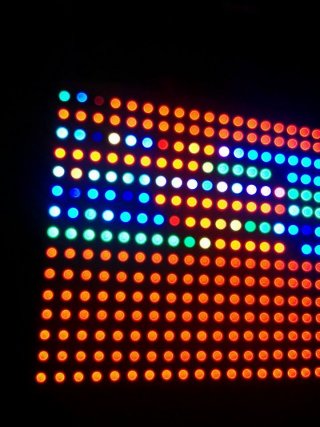Hi this is my first post because I recently decided to make a project with leds and I founf this amazing forum, since I am a newbie I hope you guys can help me and sorry if I make some dumb questions.
The thing is that I want to make a 2x2 ft (60x60 cm) panel led with audio animations, the thing is that I am about to buy 11 30/m 1m led strips and a 3.1 teensy with it's octows2811 adapter but I read that you have to cut something in the corner so you can supply the teensy with 5 V but I also read that the adaptor has a buffer chip so I am not sure if I need to cut the teensy or it is not necessary, another question, I have a 5V 10 amp power supply to power the 11 strips and I am not sure if I need another 5V 10amp supply; if I am going to use more than 8 strips do I need another teensy because I was wondering, the adapter has a jack with 2 slots for 2 CAT6 cables, 8 strips each cable, with 1 teensy i should be able to connect 16 strips right? Also another thing is once you solder the adapter to the teensy do you have an extra pin? I mean I need an audio adapter too but since you can't use the sd card with the ws2811 adapter I am going to connect a tip31 transistor or a microphone, either way I need a pin so the teensy recognize the sound and I am not really sure if I have one pin left. The last thing is that since I am trying to make this panel wireless and with wireless I mean that you don't need a PC connected all the time for the animations, Processing is my best option? Or is there anything easier besides FFT? Thanks a lot for everything.
The thing is that I want to make a 2x2 ft (60x60 cm) panel led with audio animations, the thing is that I am about to buy 11 30/m 1m led strips and a 3.1 teensy with it's octows2811 adapter but I read that you have to cut something in the corner so you can supply the teensy with 5 V but I also read that the adaptor has a buffer chip so I am not sure if I need to cut the teensy or it is not necessary, another question, I have a 5V 10 amp power supply to power the 11 strips and I am not sure if I need another 5V 10amp supply; if I am going to use more than 8 strips do I need another teensy because I was wondering, the adapter has a jack with 2 slots for 2 CAT6 cables, 8 strips each cable, with 1 teensy i should be able to connect 16 strips right? Also another thing is once you solder the adapter to the teensy do you have an extra pin? I mean I need an audio adapter too but since you can't use the sd card with the ws2811 adapter I am going to connect a tip31 transistor or a microphone, either way I need a pin so the teensy recognize the sound and I am not really sure if I have one pin left. The last thing is that since I am trying to make this panel wireless and with wireless I mean that you don't need a PC connected all the time for the animations, Processing is my best option? Or is there anything easier besides FFT? Thanks a lot for everything.


